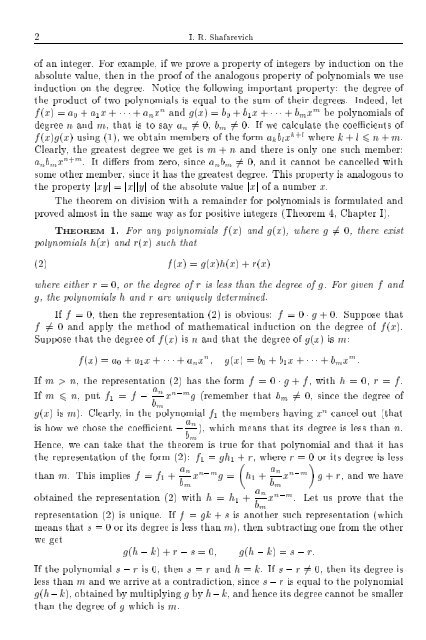SELECTED CHAPTERS FROM ALGEBRA I. R. Shafarevich Preface
SELECTED CHAPTERS FROM ALGEBRA I. R. Shafarevich Preface
SELECTED CHAPTERS FROM ALGEBRA I. R. Shafarevich Preface
Create successful ePaper yourself
Turn your PDF publications into a flip-book with our unique Google optimized e-Paper software.
2 I. R. <strong>Shafarevich</strong>of an integer. For example, if we prove a property ofintegers by induction on theabsolute value, then in the proof of the analogous property of polynomials we useinduction on the degree. Notice the following important property: the degree ofthe product of two polynomials is equal to the sum of their degrees. Indeed, letf(x) =a 0 + a 1 x + + a n x n and g(x) =b 0 + b 1 x + + b m x m be polynomials ofdegree n and m, that is to say a n 6=0,b m 6=0. If we calculate the coecients off(x)g(x) using (1), we obtain members of the form a k b l x k+l where k + l 6 n + m.Clearly, the greatest degree we getis m + n and there is only one such member:a n b m x n+m . It diers from zero, since a n b m 6= 0, and it cannot be cancelled withsome other member, since it has the greatest degree. This property is analogous tothe property jxyj = jxjjyj of the absolute value jxj of a number x.The theorem on division with a remainder for polynomials is formulated andproved almost in the same way as for positive integers (Theorem 4, Chapter I).THEOREM 1. For any polynomials f(x) and g(x), where g 6= 0, there existpolynomials h(x) and r(x) such that(2) f(x) =g(x)h(x)+r(x)where either r =0,orthedegree ofr is less than the degree ofg. For given f andg, the polynomials h and r are uniquely determined.If f =0,then the representation (2) is obvious: f =0 g +0. Suppose thatf 6= 0 and apply the method of mathematical induction on the degree of f(x).Suppose that the degree of f(x) isn and that the degree of g(x) ism:f(x) =a 0 + a 1 x + + a n x n g(x) =b 0 + b 1 x + + b m x m :If m>n, the representation (2) has the form f =0 g + f, with h =0,r = f.If m 6 n, put f 1 = f ; a nx n;m g (remember that b m 6= 0, since the degree ofb mg(x) ism). Clearly, in the polynomial f 1 the members having x n cancel out (thatis how wechose the coecient ; a n), which means that its degree is less than n.b mHence, we can take that the theorem is true for that polynomial and that it hasthe representation of the form (2): f 1 = gh 1 + r, where r = 0 or its degree is lessh 1 + a nx n;m g + r, andwehaveb mthan m. This implies f = f 1 + a nb mx n;m g =obtained the representation (2) with h = h 1 + a nb mx n;m . Let us prove that therepresentation (2) is unique. If f = gk + s is another such representation (whichmeans that s = 0 or its degree is less than m), then subtracting one from the otherwe getg(h ; k)+r ; s =0 g(h ; k) =s ; r:If the polynomial s ; r is 0, then s = r and h = k. If s ; r 6= 0, then its degree isless than m and we arrive at a contradiction, since s ; r is equal to the polynomialg(h;k), obtained by multiplying g by h;k, and hence its degree cannot be smallerthan the degree of g which ism.
















